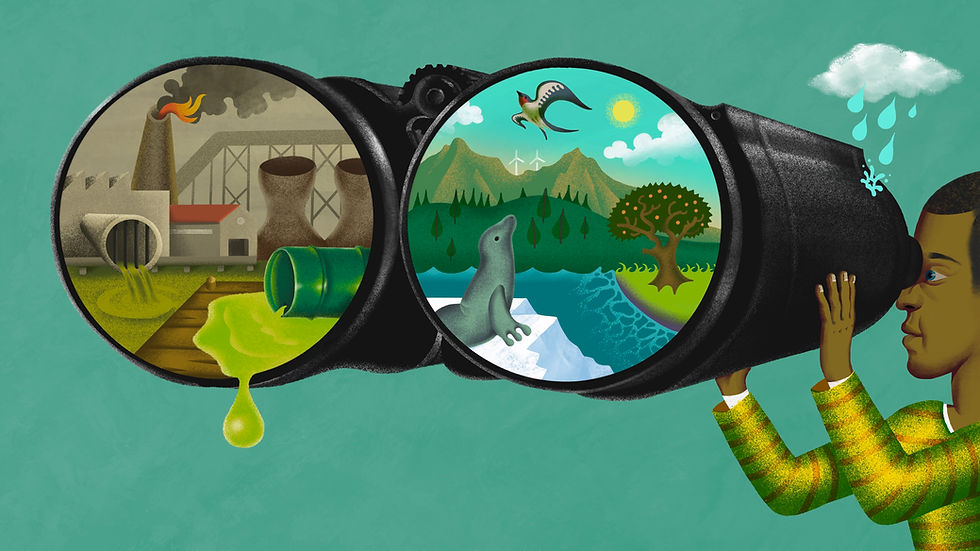Implementing IRA 2022: Clean Energy Finance - the Greenhouse Gas Reduction Fund (GGRF)
- Tom Cochran

- Jul 12, 2023
- 4 min read
The Inflation Reduction Act of 2022 was signed into law by President Biden and became Public Law 117-169 on August 16,2022 and it is a really long read. And so it takes a while to find its clean energy finance provisions in Section 60103 Greenhouse Gas Reduction Fund, under the jurisdiction of the US Environmental Protection Agency (US EPA) which has an appropriation of $19.97 Billion, including $8 Billion earmarked "...to make grants, on a competitive basis and beginning not later than 180 calendar days after the date of enactment of this section, to eligible recipients for the purposes of providing financial assistance and technical assistance in low-income and disadvantaged communities..."

According to Section (b) Use of Funds: " An eligible recipient that receives a grant pursuant to subsection (a) shall use the grant in accordance with
the following:
‘‘(1) DIRECT INVESTMENT.—The eligible recipient shall—
‘‘(A) provide financial assistance to qualified projects
at the national, regional, State, and local levels;
‘‘(B) prioritize investment in qualified projects that
would otherwise lack access to financing; and
‘‘(C) retain, manage, recycle, and monetize all repayments
and other revenue received from fees, interest,
repaid loans, and all other types of financial assistance
provided using grant funds under this section to ensure
continued operability.
‘‘(2) INDIRECT INVESTMENT.—The eligible recipient shall
provide funding and technical assistance to establish new or support existing public, quasi-public, not-for-profit, or nonprofit
entities that provide financial assistance to qualified projects
at the State, local, territorial, or Tribal level or in the District
of Columbia, including community- and low-income-focused
lenders and capital providers.
‘‘(c) DEFINITIONS.—In this section:
‘‘(1) ELIGIBLE RECIPIENT.—The term ‘eligible recipient’
means a nonprofit organization that—
‘‘(A) is designed to provide capital, leverage private
capital, and provide other forms of financial assistance
for the rapid deployment of low- and zero-emission products,
technologies, and services;
‘‘(B) does not take deposits other than deposits from
repayments and other revenue received from financial
assistance provided using grant funds under this section;
‘‘(C) is funded by public or charitable contributions;
and
‘‘(D) invests in or finances projects alone or in conjunction
with other investors.
‘‘(2) GREENHOUSE GAS.—The term ‘greenhouse gas’ means
the air pollutants carbon dioxide, hydrofluorocarbons, methane,
nitrous oxide, perfluorocarbons, and sulfur hexafluoride.
‘‘(3) QUALIFIED PROJECT.—The term ‘qualified project’
includes any project, activity, or technology that—
‘‘(A) reduces or avoids greenhouse gas emissions and
other forms of air pollution in partnership with, and by
leveraging investment from, the private sector; or
‘‘(B) assists communities in the efforts of those communities
to reduce or avoid greenhouse gas emissions and
other forms of air pollution.
‘‘(4) ZERO-EMISSION TECHNOLOGY.—The term ‘zero-emission
technology’ means any technology that produces zero emissions
of—
‘‘(A) any air pollutant that is listed pursuant to section
108(a) (or any precursor to such an air pollutant); and
‘‘(B) any greenhouse gas".
In my prior work for the US Energy Department's Office of Loan Programs as it was rolling out the Section 1703 and 1705 loan guarantee programs for innovative and commercially proven renewable energy projects projects, respectively, my colleague Steve Klein and I were tasked with identifying potential state and local government risk-sharing partners interested in expanding their own existing loan and grant programs which were already helping finance clean energy projects in their jurisdictions. Many of these entities were broadly-purposed economic development agencies of state or local government. More than a decade later, some of these financing programs have morphed into "Green Banks" focused on renewable energy and energy efficiency project finance. Other Green Banks and similar entities have been formed de novo by sponsoring state and local jurisdictions.
There is now a non-profit association of state and local Greenbanks and similar public entities investing in clean energy project using commercially proven technologies: the American Green Bank Consortium, which has accumulated an impressive array of partners and funders of members, including leading NEMW foundations such as the Rockefeller Brothers Fund, the Energy Foundation, and the Cleveland Foundation.
Given the tight September 30, 2024 deadline for EPA to obligate the $19.97 (as well as $7 Billion for the "Solar for All program" providing grants to States, Tribal governments, municipalities, and nonprofits to expand the number of low-income and disadvantaged communities that are primed for residential and community solar investment) it will be interesting to see if - and if so, how - the EPA will utilize this existing network of clean energy lenders to get capital moving to actual project borrowers. It hard to tell from this GGRF Implementation Framework released in April 19, 2023 by EPA, which is still searching for a permanent head of the GGRF.

In the coming months, and with the able assistance of Institute Policy Research Intern Charlotte Sadelain (Dartmouth College), we will work hard to stay abreast of - and keep our partners and stakeholders informed about - what should be the rapid deployment of this extraordinary amount of new capital for renewable energy and anergy efficiency investment.

AND... watch this space for our efforts to keep abreast of the Energy Department's Title XVII guarantee program (1703 and the newly-created 1706 programs) which have been given substantial new fiscal capacity and scope to partner with state Green Banks and similar entities ("State Energy Finance Institutions" in the words of the IIJA, section 40401) which are already finding ways to support clean energy and energy efficiency project financings using commercially proven technology...



Comments